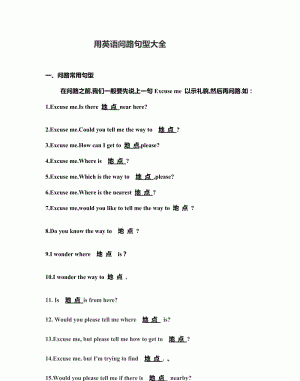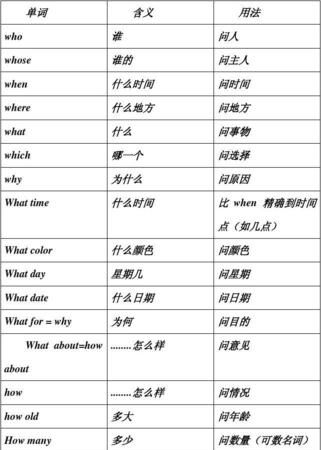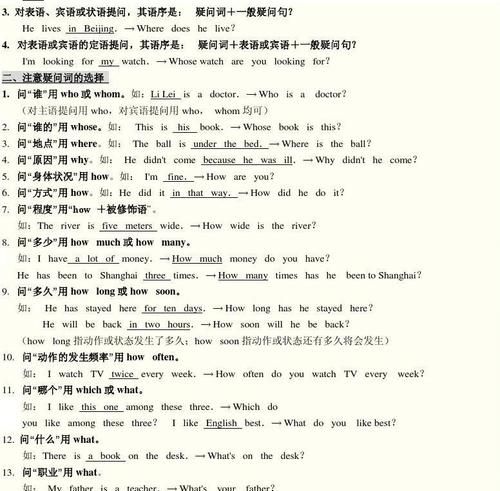本文目录
英语问句的基本句型和回答
2、一般疑问句的结构,一般疑问句有两个家族:第一家族为含be动词或情态动词的一般疑问句,其结构为:be +主语+其它部分;肯定回答用“Yes,主语+be情态动词。”否定回答用“No,主语+be情态动词+not”。
be或情态动词和not可用缩写形式,主要有isn’t,aren’t,wasn’t,weren’t,can’t,mustn’t,needn’t等;在回答时必须将this、that与these、those分别变为it和they。
另一家族为含行为动词(或称为实义动词)的一般疑问句,其结构为:助动词+主语+动词原形+其它,肯定回答用“Yes,主语+dodoes”,否定回答用“No,主语+dodoes not”。
3、助动词也常用缩写形式主要有don’t,doesn’t,didn’t等。

例句介绍如下:
1、问句:Is this your English book?
肯答:Yes,it is。
否答:No,it isn't。
2、问句:Is this your English book?
肯答:Yes,it is。
否答:No,it isn`t。
3、问句:Are these your English books?
肯答:Yes,they are。
否答:No,they aren’t。
4、问句:Can you speak English?
肯答:Yes,I can。
5、问句:Do your parents like English?
肯答:Yes,they do。
否答:No,they don’t.
6、问句:Can you speak English?
肯答:Certainly Of course。
否答:Sorry,I can’t。
英语常见问句以及回答
一、一般疑问句
1. 概念
能用yes / no(或相当于yes / no)回答的问句叫一般疑问句。
2. 含系动词be的一般疑问句的构成
具体地说,就是当陈述句中有am /is / are时,可直接将它们提至主语前,但如遇第一人称,最好将其置换成第二人称。如:
I’m in Class 2, Grade 1. →Are you in Class 2, Grade 1? 你是在一年级二班吗?
3. 含情态动词的一般疑问句的构成
一般疑问句面前人人平等:情态动词与am / is / are一样,也可直接将它们提至主语前,所以问题迎刃而解了。如:
I can spell it. →Can you spell it? 你会拼写它吗?
4. 含实义动词的一般疑问句的构成
含实义动词的一般疑问句的构成稍微有点讲究,要在句首加do;如逢主语为第三人称单数,谓语动词为一般现在时单数第三人称形式"v-(e)s"时,奉does为座上宾并要变回原形(如has→have,likes→like等);有时陈述句中的some还要变作any等。如:
She lives in Beijing. →Does she live in Beijing? 她住在北京吗?
I like English. →Do you like English? 你喜欢英语吗?
There are some books on my desk.→Are there any books on your desk?
5. 少数口语化的一般疑问句
如问一个与前文相同的问句时,可省略成"And you?"或"What / How about...?"等;甚至只抓关键词,读作升调。如:Your pen? 你的钢笔?
6. 小插曲:一般疑问句的语调
大部分的一般疑问句都应读作升调(↗),并落在最后一个单词身上。如:Is it a Chinese car↗?
7. 一般疑问句的应答
用yes / no(或相当于yes / no的词)回答,并怎么问怎么答(句首为情态动词am / is / are还是do /does),简略回答时要注意缩写(否定的n’t)和采用相应的人称代词以避免重复:即"Yes,主语(代词)+情态动词或am / is / are或do / does."表示肯定;"No,主语(代词)+情态动词或am / is / are或者do / does not(n’t)."表示否定。如:
① -Is Mary a Japanese girl? 玛丽是日本女孩吗?
-Yes, she is. / No, she isn’t. 是的,她是。/不,她不是。
② -Can Lily speak Chinese? 莉莉会说中国话吗?
-No, she can’t. / Sorry, I don’t know. 不,她不会。/对不起,我不知道。
③ -Do you like English? 你喜欢英语吗?
-Yes, very much. 是的,非常喜欢。
二、特殊疑问句
以疑问词开头,对句中某一成分提问的句子叫特殊疑问句。常用的疑问词有:what who whose which when where how why等。
特殊疑问句有两种语序:
1.如疑问词作主语或主语的定语,即对主语或主语的定语提问,其语序是陈述句的语序:疑问词(+主语)+谓语动词+其他成分?如:
who is singing in the room﹖
whose bike is broken﹖
2.如疑问词作其他成分,即对其他成分提问,其语序是:疑问词+一般疑问句语序? 如:
what class are you in﹖
What does she look like﹖
Where are you from﹖
What time does he get up every morning﹖
How do you know﹖
注意:
1.回答特殊疑问句时,不能用yes / no,即问什么答什么,尤其是简略回答。如:
Who is from Canada﹖
Helen (is).
Where's the restaurant﹖
Near the station.
Why do you like koalas﹖
Because they are cute.
2.特殊疑问句一般读降调(↓)。

英语中的问句类型有哪些
一般疑问句。
2. 特殊疑问句 。
3. 选择疑问句。
4. 反意疑问句。
特殊疑问句:
特殊疑问句是以特殊疑问词开头,对句中某一成分提问的句子叫特殊疑问句。常用的疑问词有:what 、who 、whose 、which 、when 、where 、how 、why等。
一般疑问句:
一般疑问句是疑问句的一种。它是指用yes(是)或no(否)来回答的句子。其结构是:
系动词be/助动词/情态动词+主语+其他成分。
选择疑问句:
选择疑问句是用or连接询问的两部分,以供选择,答案必须是完整的句子或其省略形式,不能用Yes或No回答一般提出两种或两种以上的可能,问对方选择哪一种.其结构可用一般疑问句,也可用特殊疑问句.供选择的两部分用or连接。
反义疑问句:
(The Disjunctive Question 或 Question tags) 即附加疑问句。它表示提问人的看法,没有把握,需要对方证实。 反义疑问句由两部分组成:前一部分是一个陈述句,后一部分是一个简短的疑问句,两部分的人称时态应保持一致。
主要形式:陈述部分肯定式+疑问部分否定式 ;陈述部分否定式+疑问部分肯定式 。

英语句型分析的软件
从英语的句子结构上说,除了修饰名词的定语和修饰动词的状语外,在千变万化的句子中可归纳为五个基本句式,一般地说,某些动词用在某一句式中,下面笔者把这些句型和常用的动词进行归类,供你参考。
1.S(主) + Vi(不及物动词)(谓)
Time flies.
1) S + V + adverbial(状语)
Birds sing beautifully.
2) S + Vi+ prep Phrase(介词短语)
He went on holiday.
3) S + Vi+ Infinitive (不定式)
We stopped to have a rest.
4) S + Vi+ Participle (分词)
I'll go swimming.
2. S (主)+ Vt (及物动词)(谓)+ O(宾)
We like English.
1) S + VT + N/Pron
I like music.
I like her.
2) S + VT + infinitive(不定式)
I want to help him.
常用于这句型的动词有:attempt, dare, decide, desire, expect, hope, intend, learn, need, offer, pretend, promise, propose, purpose, refuse, want, wish等。
3) S + VT + Wh-Word + Infinitive
I don't know what to do.
常用于这句型的动词有:ask, consider, decide, discover, explain, find out, forget, guess, inquire, know, learn, observe, remember, see, settle, tell, think, understand, wonder等。
4) S + VT + Gerund
I enjoy living here.
常用于这句型的动词有:admit, advise, avoid, consider, defend, enjoy, excuse, finish, forbid, mind, miss, practise, risk, suggest, give up, can't help等。
5) S + VT + That-clause
I don't think (that) he is right.
常用于这句型的动词有:Admit, believe, command, confess, declare, demand, deny, doubt, expect, explain, feel(觉得), hear(听说), hope, imagine, intend, know, mean, mind(当心), notice, propose, request, report, say, see(看出),show, suggest, suppose, think, understand, wish, wonder(觉得奇怪)。
3. S (主)+ V(谓)(lv)( 系动词)+ P(表)
We are Chinese.
除了be 系动词外,还有一些动词也可以用作系动词,1)表感官的动词,feel, smell, taste, sound, look, appear, seem 等。2) 表转变变化的动词,become, get, grow, turn, go,等。 3)表延续的动词 remain, keep, seem, hold, stay, rest等。4)表瞬时的动词 come, fall, set, cut, occur等 5)其他动词 eat, lie, prove, ring, run, shine, sit, stand, continue, hang等。
1) S + Lv + N/Pron(名词/代词)
He is a boy.
This is mine.
2) S + Lv + Adj(形容词)
She is beautiful.
3) S + Lv + Adv (副词)
Class is over.
4) S + Lv + Prep Phrase
He is in good health.
5) S + Lv + Participle(分词)
He is excited.
The film is interesting.
4. S (主)+ VT (谓)+ In O(间接 宾) + D O(直接 宾)
I give you help.
1) S + VT + N/Pron + N
I sent him a book.
I bought May a book.
2) S + VT + N/Pron + To/for-phrase
He sent a book to me.
He bought a coat for me.
间接宾语前需要加to 的常用动词有:allow, bring, deny, do(带来), give, grant, hand, leave, lend, offer, owe, pass, pay, permit, promise, read, refuse, render, restore, sell, send, show, teach, tell wish, write等。
间接宾语前需要加for 的常用动词有:bring, buy, cash, choose, fetch, get, leave, make, order, paint, play(演奏),save, sing, spare等。
5. S (主)+ VT(谓)+ O(宾) + O C(宾补)
I make you clear.
1) S + VT + N/Pron + N
We named our baby Tom.
常用于这句型的动词有:appoint, call, choose, elect, entitle, find, make, name, nominate(命名)。
2) S + VT + N/Pron + Adj
He painted the wall white.
常用于这句型的动词有:beat, boil, cut, drive, find, get, hold, keep, leave, like, make, paint, see, set, turn, want, wash, wipe, wish等。
3) S + VT + N/Pron + Prep Phrase
She always keeps everything in good order.
4) S + VT + N/Pron + Infinitive
I wish you to stay.
I made him work
常用于这句型的动词有:a)不定式带to的词:advice, allow, ask, beg, cause, choose, command, decide, encourage, expect, force, get, hate, invite, know, leave, like, love, order, permit, persuade, prefer, remain, request, teach, tell, want, warn, wish等。b)不定式不带to的词:feel, have, hear, know, let, listen to, look at, make, notice, see, watch等。
5) S + VT + N/Pron + Participle (分词)
I heard my name called.
I feel something moving.
常用于这句型的动词有:catch, feel, find, get, have, hear, imagine, keep, leave, listen to, look at, notice, observe, perceive, see, set, smell, start, watch等。
6) S + VT + N/Pron + Wh-word + Infinitive
He show me how to do it.
常用于这句型的动词有:advise, ask, inform, show, teach, tell等。
7) S + VT + N/Pron + That-clause
He told me that the film was great.
常用于这句型的动词有:assure, inform, promise, remind, teach, tell, warm等。
8) S + VT + N/Pron + Wh-Clause
He asked me what he should do.
常用于这句型的动词有:Advise, ask, inform, show, teach, tell.
To the top(回页首)
英语常用句型
赵宝斌 编辑 整理
初学英语的人常常感到在掌握一些英语单词和基本语法后,在英语说和写方面还是很难表达自己,笔者认为其中一个原因是没有掌握一些英语句型,只有掌握了一些句型才能比较正确、完整地表达自己。下面是笔者收集的一些常用句型。
1. 否定句型
1) 一般否定句
I don't know this. No news is good news.
There is no person (smoke)/not a person/not any person (smoke) in the house.
2)特指否定
He went to his office, not to see him.
I am sorry for not coming on time.
I don't think/believe/suppose/feel/imagine you are right.
3)部分否定
All the answers are not right
All is not gold that glitters
I don't know all of them.
I can't see everybody/everything.
Both of them are not right.
4)全体否定
None of my friends smoke.
I can see nothing/nobody.
Neither of them is right.
Nothing can be so simple as this.
5) 延续否定
You didn't see him, neither/nor did I.
You don't know, I don't know either.
He doesn't know English, let alone/to say nothing of/not to speak of (更不用说) French.
6) 半否定句
We seldom/hardly/scarcely/barely hear such fine singing.
I know little English. I saw few people.
7) 双重否定
You can't make something out of nothing.
What's done cannot be undone.
There is no sweet without sweat.
No gain without pains.
I can't help /keep/ laughing whenever I hear it.
No man is so old but (that) he can learn.
8)排除否定
Everyone is ready except you.
He did nothing but play.
But for your help, I couldn't do it.
9)加强否定
I won't do it at all.
I can't see it any more.
He is no longer a boy.
2. 判断句型
1) 一般判断句
It is important for us to learn English.
It is kind of you to help me
sincere means honest.
The boy is called/named Tom.
We regarded/consider it as an honor.
2)强调判断
It is English that we should learn.
It is he who helped me a lot.
3)弱式判断
Your sentence doesn't sound/look/appear/feel right.
You look/seem as if/as thought you had been there before.
Maybe/Perhaps/ she is ill.
He is probably ill.
He is likely ill.
It is possible that he is late
4) 注释判断
He can remember so many English words, that is (to say) he is a living dictionary.(活字典)
5) 正反判断
That sounds all right, but in fact it is not.
6) 比较判断
It is more a picture than a poem.
7) 互斥判断
He or you are wrong.
Either he is right or I am.
3. 祝愿祁使句式
1) 一般句式
Study hard and keep fit.
Be brave! Don't be shy!
Get out of here.
2)强语式
Do tell me.
Never tell a lie.
3) 委婉祈使句
Please tell me the true.
Would/Will/Won't do me a favor?
Would/Do you mind my smoking?
What/How/ about going on foot?
4)建议祈使句
Let us go. Let us know the time.
Don't let the fire out.
Let's not waste the time.
You'd better start early.
Shall we listen to some music?
Why don't you get something to drink?
Suppose/supposing you pick me up at about six?
I suggest we (should) take the train.
5)祝愿句
Success to you!
Wish you a good journey.
May you have a happy marriage.
Here's to your success!
Allow me to propose a toast to our friendship!
4. 感叹句型
How well he speaks!
How kind she is!
What a nice weather it is!
Here he comes!
Such is life!
Wonderful!
Help!
5. 疑问句型
1) 一般疑问句
Is he a doctor?
Do you the way to the station?
2)反意疑问句
He is a teacher, isn't he?
It is quite cheap, don't you think?
3) 特殊疑问句
What is the distance/width/size/population/temperature/fare?
Who is he?
What is he?(干什么的)
What is he like?
How is he?
How do you like him?
What do you think of him?
What ever do you mean by saying this?
4)选择疑问句
He is a doctor or a nurse?
5)间接疑问句
Do you know how old he is?
Tell me if (whether) you like it.
What do you think/say/suppose I should do?

以上就是关于英语提问句型大全归纳,英语问句的基本句型和回答的全部内容,以及英语提问句型大全归纳 的相关内容,希望能够帮到您。

